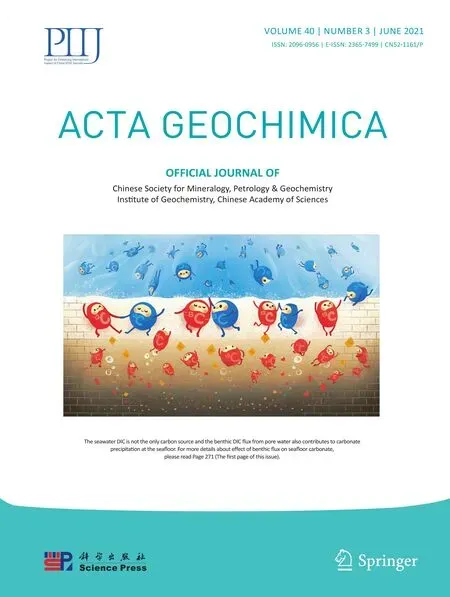Trace and rare earth element geochemistry of the black and grey shales of the Calabar Flank,Southeastern Nigeria:constraints on the depositional environment and the degree of metal enrichment
Christopher Iorfa Adamu·Benjamin Odey Omang·Oluwaseye Peter Oyetade·Otu Johnson·Therese Ntonzi Nganje
Abstract This study focuses on the trace and rare earth elements(REE)geochemistry of the Nkporo and Ekenkpon Shales of the Calabar Flank.The main aim is to infer their depositional environment and the degree of their metal enrichment.The shale samples were analyzed using inductively coupled plasma mass spectrometry.The results indicated that the mean concentrations of K,Na,and Fe in Nkporo and Ekenkpon Shales are 1.45,0.4,and 4.17 wt%,and 1.11,0.44,and 5.42 wt%;respectively.The Nkporo Shale is enriched with the following trace elements;P>Mn>Sr>Ba>Zn>Ce>Rb>Zr>V>Cr>Ni and depleted in the following trace elements;Ta>Ge>Sb>Bi>Cd>Ag>Te>In>Hg.While the Ekenkpon Shale is enriched with the following trace elements;P>Mn>Ba>Sr>V>Ce>Zr>Rb>Cr>Zn>Ni and depleted in;Sb>Ge>Bi>Ag>Ce>Te>In>Hg.The concentration of redox-sensitive elements such as V,Ni,Mo,U,Cu,Cr,Re,Cd,Sb,Ti,Mn,and their ratio V/Mo and U/Mo in the black and grey shale samples show different patterns.The REE obtained from the Nkporo and Ekenkpon Shales were PAAS normalized.The Nkporo Shale showed a slightly f lat light rare-earth element(LREE),middle rare-earth element(MREE),and heavy rare earth element(HREE)pattern enrichment.Ce/Ce*ranges from 0.95 to 1.09 in Nkporo Shale and 0.67 to 1.40 in Ekenkpon Shale.The Ekenkpon Shale showed a slight LREE,MREE enrichment,and depleted HREE patterns.The Mn contents and U/Mo ratio in Nkporo and Ekenkpon Shales suggests a poor oxygen transitional environment.The V/Mo and V/(V+Ni)ratios indicated that the Nkporo shales were deposited in an anoxic to suboxic conditions and Ekenkpon shales were also deposited under an anoxic to suboxic conditions.The V/Ni ratio indicated that the organic matter in the Nkporo shale is terrigenous while that of the Ekenkpon shales are both terrigenous and marine in origin.
Keywords Rare-earth elements(REE)·Trace elements·Calabar Flank·Suboxic·Anoxic
1 Introduction
In most hydrocarbon producing clastic sedimentary basins of the world,shales are referred to as the source rock,because of their hydrocarbon generating potential.Shales contain organic matter(kerogen).This kerogen(type 1–4)is made up of several materials such as micro-organisms,sea plants,and land plants.The kerogen type determines the type of hydrocarbon that will be produced either oil or gas.Shales are f ine-grained,clastic sedimentary rocks that comprise of mud materials,i.e.a mixture of f lakes of clay minerals and tiny fragments(silt-sized particles)of other minerals,especially quartz and calcite(Harvey and Tracy 1996).Shale is a general term used to refer to any mudrock possessing f issility.The typical color of shale is grey,however,a variable amount of minor constituents alters the color of the rock.For instance,black shales result from the presence of greater than one percent carbonaceous materials/organic matter, and the color indicates a reducing environment.
The shales in the Niger Delta Basin of Nigeria has been examined by many researchers owing to the fact that the basin has enormous petroleum reserves estimated at 30 billion barrels of oil and 260 trillion cubic feet of natural gas.The worldwide ranking marks the Niger Delta as the seventh most prolif ic petroleum province with an average hydrocarbon production of about 1.8 million bbl of oil per day(Oyetade and Abada 2020).Therefore,there is the need to start evaluating other sedimentary basins in the country for their hydrocarbon potentials,so as to increase the country’s revenue from hydrocarbon.The Calabar Flank of the Lower Benue Trough contains two major shale units the Ekenkpon and Nkporo Formations.This study intends to examine the two major shale units of the Calabar Flank for their depositional environments and degree of metal enrichment,and predict their organic matter sources in order to access the shales hydrocarbon generation potentials.As a proper investigation of the environment of deposition helps in predicting the quality of the source rock(shale)and unconventional resources(Zuo et al.2020).
However,trace element geochemical studies of sedimentary basins are useful indicators of sulf ide mineralization,depositional environment,facies,and diagenetic changes(Lewis Jr and Bandeira 1981;Ajayi et al.2006).And rare earth elements(REE)are known to be more resistant to fractionation by weathering and metamorphism than any other trace element(Nance and Taylor 1974).
Geochemical studies were employed to examine the Ekenkpon and Nkporo Shale Formations for their depositional environments,degree of metal enrichment,and predict their organic matter sources,as different types of kerogen are formed in shales under different sedimentary environments,hence this study.
1.1 Study area
The study area is located within the Lower Benue Trough.The Lower Benue Trough consists of two(2)basins:the Anambra and the Calabar Flank.The geographic coordinate of the sample locations(latitudes and longitudes)falls within the Calabar Flank(Fig.1a,b).The coordinates of the samples are presented in Table 1.

Table 1 Geographic coordinate of the samples locations
1.2 Geologic settings
The Calabar Flank forms part of the southeastern Nigeria continental margin lying between the Cameroon volcanic line on the east,Ikpe platform on the west,Oban massif to the north and Calabar hinge line to the south.The Calabar Flank lies between latitudes 5°00and 5°15N and between longitudes 8°15E and 8°30E(Fig.1a).
The Calabar Flank is dominated by block faults with horst and graben trending in the NW–SE direction.These structures are the Ituk high and the Ikang trough.The Calabar Flank contains marine sediments up to 4000 m of Albian to Maastrichtian age(Ehinola et al.2008).Sedimentation in Calabar Flank began with the deposition of f luvio-deltaic clastics probably Aptian in age,accumulating in a prograding deltaic margin as deltaic and non-marine sediments.These sediments belong to the Awi Formation(Obaje 2009).The carbonate rock(Mfamosing Limestone)which was deposited in mid-Albian time overlies the Awi formation.Overlying the Mfamosing Limestone is a thick sequence of highly f issile shale with minor but frequent intercalations of marls and calcareous mudstone(the Ekenkpon shale).This thick shale sequence spans late Albian-Cenomanian–Turonian in age.A thick marl unit with thin dark shale intercalations(the New Netim Marl)overlies the Ekenkpon shale.The Santonian and Early Campanian sediments are not encountered,and this period is regarded as a period of non-deposition and/or erosion in the Calabar Flank.The Late Campanian–Maastrichtian Nkporo Shale(NS)overlies the New Netim Marl unconformably(due to the absence of Santonian and Early Campanian sediments)above which are Tertiary marine shales and regressive sandstones.
The Awi Formation is a synrift f luviatile deposit composed of olive-brown sandy shale,f ine-grained micaceous sandstones,and bluish-grey organic-rich mudstones(Obaje 2009).The Mfamosing Formation consists of shallow marine,stratif ied platform carbonates while,the Ekenkpon(ES)and New Netim(NNM)formations were laid down during a rise in sea level,and comprise of transgressive shales and marls.The Mfamosing,Ekenkpon,and New Netim formations are results of post-rift open marine deposits.The Nkporo Shale(NS)is dark-grey shale with interbeds of sandy shale,siltstone,and mudstone representing shallow marine deposits.
Tertiary-Recent sediments known as the Benin Formation overlies the Nkporo shale.The Benin Formation is marked by lacustrine and f luvial sands,pebbles,clay,lignite,and alluvium.The stratigraphic succession of the Calabar f lank is shown in Fig.2.
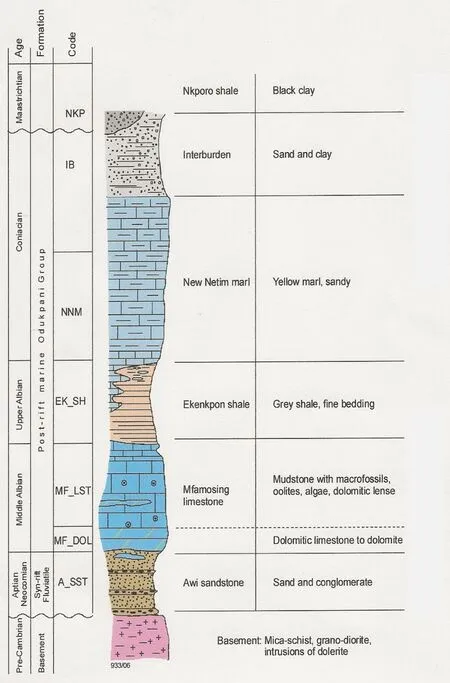
Fig.2 Stratigraphic column of Calabar Flank after Udoh(2006 unpublished)
2 Materials and methods
The shale samples of the Cenomanian–Lower Turonian Odukpani(Ekenkpon)and Campanian(Nkporo)were obtained for this study(Fig.1b).Six and f ive fresh representative shales samples were collected from the Cenomanian–Lower Turonian, Odukpani (Ekenkpon)Formation,and Campanian,Nkporo Formation;respectively.The shale samples were placed in properly labeled polythene bags to prevent loss of moisture and shipped to the laboratory for analysis.

Fig.1 a Map of southern Nigeria showing Calabar Flank;b Sample location map
The shale rock samples were crushed and sieved through 10 mesh(<2 mm)using a jaw crusher,quartered,and pulverized in a porcelain mortar to 200 mesh(<80μm),re-homogenized and packaged in sealed plastic bags for chemical analyses.0.25 g each of the powdered rock was digested by open vessel method using HCLO,HNO,and HF in a Tef lon beaker placed in a hotplate put in a fume chamber,the mixture was then ref luxed at a temperature of 90–100C for 1 h and then evaporated at a temperature ranging between 180 and 190C to dryness.The residue was then leached with 5 ml of HCl.The digested samples were f iltered through a 0.45μm syringe membrane f ilter and made up to 10 ml with ultra-high purity water.The shale solution samples were analyzed for trace and rare earth element concentrations at a certif ied commercial laboratory(ACME analytical laboratories Ltd.Vancouver Canada)by inductively coupled plasma mass spectrometry(ICP-MS).The accuracy and precision of the analyses were assessed by introducing two blank samples,two sample duplicates,and one international reference material,United State Geological Survey(USGS)sedimentary reference material(MAG-1)for rock.The quality assurance and quality control(QA/QC)protocol were carried out as described by Environment Canada(1978)and random duplicate samples were analyzed.The instrument was calibrated before and during analysis.
3 Results
3.1 Major elements
The major elements in Nkporo Shale(NK SH)are as follows;Aluminium(Al)was observed to have the highest mean value of 6.32±1.35 and a concentration ranging from 4.30 to 7.99 wt%.Calcium(Ca)was observed to have the second-highest mean value in the Nkporo Shale of 5.52±2.01 and its range from 3.20 to 8.32 wt%.
Iron(Fe)concentration range from 2.87 to 6.37 wt%with a mean of 4.178±1.446,potassium(K)range from 0.02 to 2.65 wt%with a mean of 1.45±0.978 wt%and sodium(Na)concentration range from 0.01 to 1.21 wt%with a mean value of 0.4±0.473 wt%.The Na/K ratios in Nkporo Shale range from 0.066 to 0.500(Table 2).The major elements’distribution patterns in Nkporo Shale are shown in Fig.3.
Aluminum(Al),Calcium(Ca),and Iron(Fe)were observed to have the highest major elements in the Ekenkpon Shale.Aluminum(Al)concentrations range from 5.10 to 9.01 wt% with a mean value of 6.63±1.65 wt%,Calcium(Ca)concentrations range from 3.10 to 7.12 wt%with a mean value of 5.47±1.55 wt%.Iron(Fe)concentration ranges from 3.95 to 7.18 wt%with a mean value of 5.423±1.286 wt%,sodium(Na)concentration range from 0.25 to 1.02 wt%with a mean value of 0.448±0.288 wt%and Potassium(K)concentrations range from 0.85 to 1.37 wt% with a mean of 1.11±0.177 wt%was observed from the Ekenkpon Shale(EK SH).The Na/K ratios in the Ekenkpon shale range from 0.243 to 0.745(Table 2).The major elements’distribution patterns in Ekenkpon shale are shown in Fig.4.
3.2 Trace elements
Forty trace elements were analyzed for both Nkporo and Ekenkpon Shales,these elemental compositions are presented in Table 3.The mean values above f ifty ppm(>50)were categorized as distinctively high values,mean values between one and f ifty ppm(1–50)were categorized as medium mean values and the trace elements mean values lower than 1(<1)are categorized as depleted elements in the shale.
The mean values of the trace elements concentration in the Nkporo Shale range from 0.006 to 1827.8 ppm(Table 3).Phosphorus(P)is the most abundant trace element in Nkporo Shale with concentration ranging from 1045 to 2560 ppm and a mean value of 1827.8 ppm,followed by Manganese(Mn)with concentration ranging from 202 to 890 ppm and a mean value of 544.8 ppm.
Strontium(Sr)with concentration ranging from 374 to 508 and a mean value of 417 ppm.Barium(Ba)with a mean value of 342 ppm and concentration ranging from 166 to 700 ppm.Other trace elements with distinctive high mean values are;Zinc(Zn)115.7 ppm,Cerium(Ce)106.48,Rubidium (Rb)90.92 ppm,Zirconium (Zr)86.28 ppm,Vanadium(V)85.3 ppm,Chromium(Cr)64 ppm and Nickel(Ni)55.68 ppm.
Trace elements concentration that is categorized as medium mean value elements in the Nkporo shale are;Yttrium (Y)with concentration ranging from 19.3 to 129.5 ppm and a mean value of 45.22 ppm followed by Molybdenum(Mo)with a mean value of 35.76 ppm and concentration ranging from 17.8 to 43.9 ppm.Lithium(Li)concentration ranging from 26.8 to 45.9 ppm and a mean value of 35.44 ppm.Lead(Pb)with concentration ranging from 19.2–34 ppm with a mean value of 25.94 ppm.Others show mean values of 22.75 ppm Tungsten(W),22.62 ppm Copper (Cu), 20.43 ppm Cobalt (Co),19.12 ppm Gallium(Ga),15.86 ppm thorium(Th),13 ppm niobium(Nb),10.81 ppm Scandium(Sc),5.80 ppm Uranium(U),4.50 ppm Cesium(Cs),4.38 ppm Arsenic(As),3.50 ppm Selenium(Se),2.59 ppm Tin(Sn),2.48 ppm Hafnium(Hf)and 1.93 ppm Beryllium(Be).
The Nkporo shale shows depletion in concentrations of the following mean trace elements;tantalum (Ta)0.772 ppm,germanium(Ge)0.43 ppm,antimony(Sb)0.2 ppm,bismuth(Bi)0.18 ppm,cadmium(Cd)0.16 ppm,sliver(Ag)0.092 ppm,tellurium(Te)0.052 ppm,indium(In)0.049 ppm and mercury(Hg)0.006 ppm.
The mean values of the trace elements concentration in the Ekenkpon shale range from 0.0083 to 564.17 ppm.Phosphorus(P)(402–756 ppm)and a mean value of(564.17 ppm),Manganese(Mn)(198–401 ppm),and a mean value of 283 ppm.Barium(Ba)(176–435 ppm)with a mean value of 281.17 ppm.Other trace elements with distinctive high mean values are;Sr(250.87 ppm),V(115.67 ppm),Ce (99.53 ppm),Zr(96.93 ppm),Rb(93.33 ppm),Cr(74.27 ppm),Zn(67.5 ppm)and Ni(59.97 ppm).
Medium mean value trace element concentrations are;Mo(31.87 ppm),Li(35.74 ppm),Y(29.67 ppm),Cu(25.97 ppm),Pb(21.85 ppm),Ga(20.5 ppm),Co(18.58 ppm),Th (17.2 ppm),Sc (12.21 ppm),W (9.55 ppm),U(5.49 ppm),Cs(4.99 ppm),As(3.42 ppm),Sn(3.05 ppm),Se (2.96 ppm),Hf(2.58 ppm),Be (1.48 ppm),Ta(1.33 ppm)and Ti(1.25 ppm).
Depleted trace elements in the Ekenkpon shale are;Sb(0.28 ppm),Ge(0.21 ppm),Bi(0.18 ppm),Ag(0.07 ppm),Ce(0.06 ppm),Te(0.046 ppm),In(0.038 ppm)and Hg(0.008 ppm).

Samples Al Fe Ca Mg Na K Ti Na/K NKP 1 6.81 2.87 4.96 0.59 1.21 2.65 0.352 0.46 NKP2 7.99 6.37 8.32 0.89 0.37 1.39 0.385 0.27 NKP 3 6.56 4.89 6.71 0.76 0.28 1.21 0.379 0.23 NKP 4 5.96 3.56 4.43 0.35 0.13 1.98 0.41 0.07 NKP 5 4.3 3.2 3.2 0.54 0.01 0.02 0.45 0.5 Mean(n=5) 6.32 4.18 5.52 0.63 0.40 1.45 0.40 0.31 SD 1.35 1.45 2.01 0.21 0.47 0.98 0.04 Range 4.3–7.99 2.87–6.37 3.2–8.32 0.35–0.89 0.01–1.21 0.02–2.65 0.352–0.45 EK SH 1 5.1 4.1 3.1 0.41 0.41 0.85 0.51 0.48 EK SH2 5.85 6.54 6.57 0.67 0.25 1.03 0.65 0.24 EK SH 3 9.01 5.32 7.12 0.75 0.28 1.05 0.41 0.27 EK SH 4 8.35 7.18 6.19 0.81 1.02 1.37 0.381 0.75 EK SH 5 6.25 3.95 4.1 0.37 0.32 1.15 0.45 0.28 EK SH 6 5.23 5.45 5.72 0.28 0.41 1.21 0.29 0.34 Mean(n=6) 6.63 5.42 5.47 0.55 0.45 1.11 0.45 0.39 SD 1.65 1.29 1.55 0.22 0.29 0.18 0.12 Range 5.1–9.01 3.95–7.18 3.1–7.12 0.28–0.81 0.25–1.02 0.85–1.37 0.29–0.65

3.3 Rare earth element
The values of the rare earth element(REE)obtained from the Nkporo and Ekenkpon Shale are presented in Table 4.The PAAS Normalized REE distribution pattern of Nkporo and Ekenkpon Shales are shown in Fig.5.The Nkporo Shale shows a slightly f lat light rare-earth element(LREE),middle rare-earth element(MREE),and heavy rare earth element(HREE)pattern enrichment in the samples of the Nkporo Shale(Fig.5a)and a lesser degree of depletion in Nd,Dy,and Er.
The Nkporo Sample NK 4 is the only sample that shows a distinct increment in REE concentration to other Nkporo Shale samples but it follows the same REE distribution pattern with other Nkporo samples(Fig.5a).Ce/Ce*ranges from 0.95 to 1.09 in the Nkporo shale.The Ekenkpon shale shows a slight LREE,MREE enrichment,and depleted HREE patterns(Fig.5b).A distinct depletion is observed for Eu and a slight depletion for Dy(Fig.5b).The Ce/Ce*ranges from 0.67 to 1.40.

4 Discussion
4.1 Major elements
The mean values of the major elements;K,Na,and Fe concentrations obtained for Nkporo shale were compared with the mean values obtained by Duncan(1981)(an arithmetic average of 18 H.W drill core samples).The K mean value of Duncan(1981)is higher than that of the Nkporo Shale,while Na and Fe mean values of Nkporo Shale is relatively higher to Duncan(1981).The K and Na mean values of Clark and Etnst(1970),(the average of 78 Mesozoic and Cenozoic shale)are relatively higher to that of Nkporo shale,whereas the Fe mean value of Clark and Etnst(1970)is relatively similar to that of Nkporo shale and they show similar curve pattern(Fig.6).The K,Na,and Fe of Nkporo shale are relatively higher than the Ifon Black shale(Ajayi et al.1989).The Fe enrichment of Nkporo shale is relatively similar to Oshosun Gery and Black Shales(Ajayi et al.2006)but the K and Na enrichments vary in the shale samples.The Fe mean value of Ekenkpon Shale is slightly higher than Nkporo Shale,while the K and Na mean values are relatively similar(Table 5 and Fig.6).The mean values of the major elements;Fe and Na of Ekenkpon Shale is higher than that of Duncan(1981),while the mean value of K in Duncan(1981)is relatively higher to the Ekenkpon Shale.The mean values of K and Na in Ekenkpon Shale are lower than that of the average of 78 Mesozoic and Cenozoic shale(Clark and Etnst 1970),whereas the Fe mean value of Ekenkpon is greater than that of Clark and Etnst(1970).
The mean values of Ekenkpon Shales(1.11 wt%for K,0.448 wt%for Na and 5.423 wt%for Fe)are higher than the ones obtained for Ifon Black Shale,Oshosun Grey Shale,and Oshosun Black Shale(Ajayi et al.1989,2006)Table 5.The Ekenkpon shale as well shows a close similar curve pattern to the average of 78 Mesozoic and Cenozoic shale of(Clark and Etnst 1970)Fig.6.
4.2 Trace elements
The mean values of trace elements in Nkporo Shale were compared with Turekian and Wedepohl’s Shale(Turekian and Wedepohl 1961),Black Shale(Hawkes and Webb 1962),an average of compatible elements in world’s average shale(Taylor 1964,1966,1969)and upper continental crust(Rudnick and Gao 2014)Table 6.The Barium(Ba)of Nkporo shale is relatively lower than Turekian and Wedepohl(1961),Hawkes and Webb,(1962)and Rudnick and Gao(2014).The mean value of 20.43 ppm Cobalt(Co)is in the range of the Turekian and Wedepohl’s shale(Turekian and Wedepohl 1961)and upper continental crust(Rudnick and Gao 2014),but greater than the Black Shale(Hawkes and Webb 1962).The mean value of Cr in Nkporo Shale is relatively low to that of the average compatible elements in world’s average Shale(Taylor 1964,1966,1969),upper continental crust(Rudnick and Gao 2014),and Turekian and Wedepohl’s Shale(Turekian and Wedepohl 1961)but fall within the range of Black Shale(Hawkes and Webb 1962).The mean value of Ni in Nkporo Shale is relatively higher than the upper continental crust samples(Rudnick and Gao 2014),but lower to the average of compatible elements in the world’s average shale(Taylor 1964,1966,1969).The mean values Sb of Sc in Nkporo Shale falls within the range of the average of compatible elements in the world’s average Shale(Taylor 1964,1966,1969)and the upper continental crust samples(Rudnick and Gao 2014).The Rb and Sr of Nkporo Shale are relatively higher than the average of compatible elements in world’s average Shale(Taylor 1964,1966,1969)and upper continental crust(Rudnick and Gao 2014),while Ta and Th mean values of Nkporo Shale falls within the same range with the average of compatible elements in world’s average Shale and upper continental crust.The average mean values of Se and U of Taylor(1964,1966,1969)is relatively high to the ones of Nkporo shales,but the average mean values of the Se and U in Rudnick and Gao(2014)is lower than the Nkporo shale.Ga mean value of 19.12 ppm of Nkporo Shale,relatively falls within the same range with the Turekian and Wedepohl,(1961);Rudnick and Gao(2014).The average mean values of Zr in Turekian and Wedepohl,(1961),Hawkes and Webb,(1962)and Rudnick and Gao(2014)are greater to that of Nkporo shale.
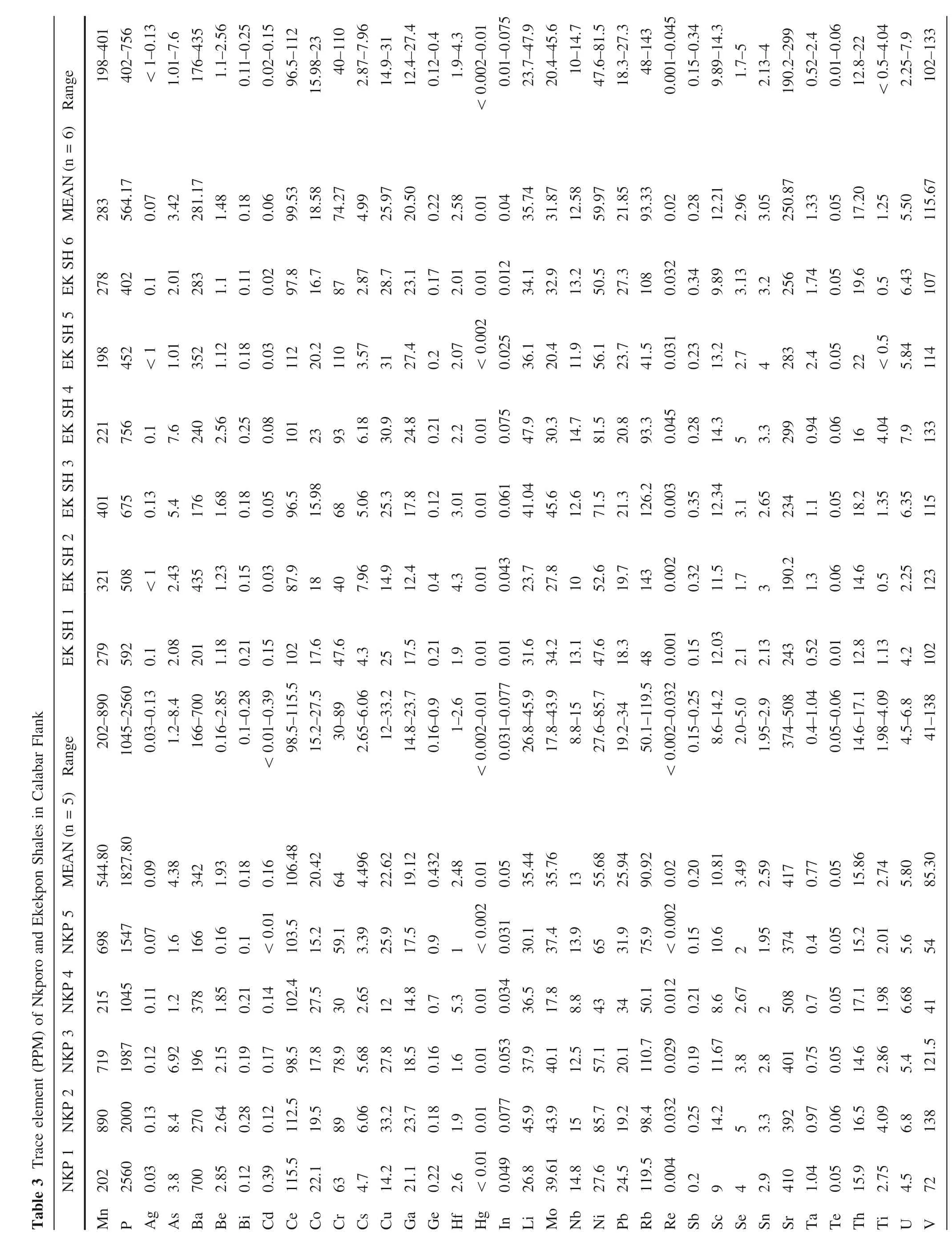
MEAN(n=6)Range 198–401 402–756<1–0.13 1.01–7.6 176–435 1.1–2.56 0.11–0.25 0.02–0.15 96.5–112 15.98–23 40–110 2.87–7.96 14.9–31 12.4–27.4 0.12–0.4 1.9–4.3<0.002–0.01 0.01–0.075 23.7–47.9 20.4–45.6 10–14.7 47.6–81.5 18.3–27.3 48–143 0.001–0.045 0.15–0.34 9.89–14.3 1.7–5 2.13–4 190.2–299 0.52–2.4 0.01–0.06 12.8–22<0.5–4.04 2.25–7.9 102–133 283 564.17 0.07 3.42 281.17 1.48 0.18 0.06 99.53 18.58 74.27 4.99 25.97 20.50 0.22 2.58 0.01 0.04 35.74 31.87 12.58 59.97 21.85 93.33 0.02 0.28 12.21 2.96 3.05 250.87 1.33 0.05 17.20 1.25 5.50 115.67 6SHEK5SHEK 278 4020.12.01 283 1.10.11 0.02 97.8 16.7 87 2.87 28.7 23.1 0.17 2.01 0.01 0.012 34.1 32.9 13.2 50.5 27.3 108 0.032 0.34 9.89 3.13 3.2256 1.74 0.05 19.6 0.56.43 107 198 452<1 1.01 352 1.12 0.18 0.03 112 20.2 110 3.57 3127.4 0.22.07<0.002 0.025 36.1 20.4 11.9 56.1 23.7 41.5 0.031 0.23 13.2 2.74283 2.40.05 22<0.5 5.84 114 4SHEK 221 756 0.17.6240 2.56 0.25 0.08 101 23936.18 30.9 24.8 0.21 2.20.01 0.075 47.9 30.3 14.7 81.5 20.8 93.3 0.045 0.28 14.3 53.3299 0.94 0.06 164.04 7.9133 3SHEK2SHEK 401 675 0.13 5.4176 1.68 0.18 0.05 96.5 15.98 68 5.06 25.3 17.8 0.12 3.01 0.01 0.061 41.04 45.6 12.6 71.5 21.3 126.2 0.003 0.35 12.34 3.12.65 234 1.10.05 18.2 1.35 6.35 115 321 508<1 2.43 435 1.23 0.15 0.03 87.9 18407.96 14.9 12.4 0.44.30.01 0.043 23.7 27.8 1052.6 19.7 143 0.002 0.32 11.5 1.73190.2 1.30.06 14.6 0.52.25 123 1SHEK 279 592 0.12.08 201 1.18 0.21 0.15 102 17.6 47.6 4.325 17.5 0.21 1.90.01 0.01 31.6 34.2 13.1 47.6 18.3 48 0.001 0.15 12.03 2.12.13 243 0.52 0.01 12.8 1.13 4.2102 Table3Traceelement(PPM)ofNkporoandEkekponShalesinCalabarFlank MEAN(n=5)Range NKP5NKP4NKP3NKP2NKP1 202–890 1045–2560 0.03–0.13 1.2–8.4 166–700 0.16–2.85 0.1–0.28<0.01–0.39 98.5–115.5 15.2–27.5 30–89 2.65–6.06 12–33.2 14.8–23.7 0.16–0.9 1–2.6<0.002–0.01 0.031–0.077 26.8–45.9 17.8–43.9 8.8–15 27.6–85.7 19.2–34 50.1–119.5<0.002–0.032 0.15–0.25 8.6–14.2 2.0–5.0 1.95–2.9 374–508 0.4–1.04 0.05–0.06 14.6–17.1 1.98–4.09 4.5–6.8 41–138 544.80 1827.80 0.09 4.38 342 1.93 0.18 0.16 106.48 20.42 64 4.496 22.62 19.12 0.432 2.48 0.01 0.05 35.44 35.76 13 55.68 25.94 90.92 0.02 0.20 10.81 3.49 2.59 417 0.77 0.05 15.86 2.74 5.80 85.30 698 1547 0.07 1.6166 0.16 0.1<0.01 103.5 15.2 59.1 3.39 25.9 17.5 0.91<0.002 0.031 30.1 37.4 13.9 65 31.9 75.9<0.002 0.15 10.6 2 1.95 374 0.40.05 15.2 2.01 5.654 215 1045 0.11 1.2378 1.85 0.21 0.14 102.4 27.5 302.65 1214.8 0.75.30.01 0.034 36.5 17.8 8.8433450.1 0.012 0.21 8.62.67 2508 0.70.05 17.1 1.98 6.68 41 719 1987 0.12 6.92 196 2.15 0.19 0.17 98.5 17.8 78.9 5.68 27.8 18.5 0.16 1.60.01 0.053 37.9 40.1 12.5 57.1 20.1 110.7 0.029 0.19 11.67 3.82.8401 0.75 0.05 14.6 2.86 5.4121.5 890 2000 0.13 8.4270 2.64 0.28 0.12 112.5 19.5 896.06 33.2 23.7 0.18 1.90.01 0.077 45.9 43.9 1585.7 19.2 98.4 0.032 0.25 14.2 53.3392 0.97 0.06 16.5 4.09 6.8138 202 2560 0.03 3.8700 2.85 0.12 0.39 115.5 22.1 634.714.2 21.1 0.22 2.6<0.01 0.049 26.8 39.61 14.8 27.6 24.5 119.5 0.004 0.2942.9410 1.04 0.05 15.9 2.75 4.572 Mn P Ag As Ba Be Bi Cd Ce Co Cr Cs Cu Ga Ge Hf Hg In Li Mo Nb Ni Pb Rb Re Sb Sc Se Sn Sr Ta Te Th Ti U V

Table3continued MEAN(n=6)Range 6.9–13.3 22.4–43.8 21–105 51.2–153 9.55 29.67 67.50 96.93 6SHEK 6.938.2 73 116 5SHEK 8.743.8 61 75.4 4SHEK 13.3 24.4 9151.2 3SHEK 10.47 26.1 105 124 2SHEK 9.523.1 21153 1SHEK 8.422.4 54 62 MEAN(n=5)Range 12.9–53.8 19.3–129.5 87–187 48–189 22.74 45.22 115.70 86.28 NKP5 12.9 19.3 187 71 NKP4 17.8 129.5 112 189 NKP3 13.8 23.6 92.5 57 NKP2 15.4 28.3 100 48 NKP1 53.8 25.4 8766.4 W Y Zn Zr
The Ba 281.17 ppm of Ekenkpon Shale is relatively lower than that of 580 ppm(Turekian and Wedepohl 1961),624 ppm of Rudnick and Gao(2014)and the range of 450–700 ppm of Black shale(Hawkes and Webb 1962).The Turekian and Wedepohl(1961)and Rudnick and Gao(2014),mean values for Co is relatively similar to that of Ekenkpon shale(Table 4),however,the Co mean value of Ekenkpon shale is higher than that of the Black Shale(Hawkes and Webb 1962).The Cr mean value of the Ekenkpon Shale is relatively lower than that of Taylor(1964,1966,1969),Turekian and Wedepohl(1961)and Rudnick and Gao,(2014),however,it falls within the range of Black Shale(Hawkes and Webb 1962).The U mean value for Ekenkpon Shale is relatively lower than that of Taylor(1964,1966,1969),but higher than Turekian and Wedepohl(1961),and Rudnick and Gao(2014).Zr in Ekenkpon Shale is relatively lower to that of Taylor(1964,1966,1969),Turekian and Wedepohl(1961),Hawkes and Webb(1962)and Rudnick and Gao(2014).
Trace element ratios of redox-sensitive elements have been used to explicate the depositional environment(Abou El-Anwar et al.2019;Jeon et al.2020).V/Mo is near to the seawater ratio(<2),it indicates an anoxic condition,a range from 2 to 10 indicates suboxic condition and a range from 10 to 60 indicates normal oxygenation(Gallego-Torres et al.2010;Abou El-Anwar et al.2019).The V/Mo ratio in the Nkporo Shale range from 1.44 to 3.14 and V/Mo in the Ekenkpon Shale range from 2.52 to 5.58,which indicates that the Nkporo Shale was deposited in an anoxic to suboxic conditions while Ekenkpon Shale deposited in suboxic conditions.Higher V/(V+Ni)ratio indicates a more strongly reducing condition(Jeon et al.2020)than under anoxic condition.V/(V+Ni)of>0.60 indicates an anoxic depositional environment,0.46 to 0.60 indicated a suboxic environment and<0.46 indicated an oxic depositional environment(Jeon et al.2020).In this study V/(V+Ni)ratio of the Nkporo Shale range from 0.46 to 0.72 which indicates were deposited under anoxic to suboxic conditions while the Ekenkpon Shale value of V/(V+Ni)is 0.62 to 70 which indicated that the Ekenkpon Shale is deposited under anoxic condition.Therefore Nkporo Shale is inferred to be deposited under anoxic to suboxic conditions and Ekenkpon Shale is also deposited under anoxic to suboxic depositional environment.

NKP 1 NKP2 NKP 3 NKP 4 NKP 5 EK SH 1 EK SH2 EK SH 3 EK SH 4 EK SH 5 EK SH 6 La 67.9 60.9 53.5 161.5 78.4 76 35 43 37 61 58 Ce 143 115 101 274 154.5 87 70.3 97.4 116 121 135 Pr 21.4 12.65 11.4 30.2 17.35 7.3 8.06 12.5 18.9 23.5 11.5 Nd 51.3 42 40.5 32.7 60.8 31 28.1 32 40.1 49.5 35.6 Sm 8.3 6.88 7.71 18.55 11.05 7.01 5.63 8.9 6.7 10.2 7.9 Eu 3.01 1.63 2 5.13 2.52 0.3 0.83 0.47 0.63 0.87 0.71 Gd 9.2 7.07 8.39 22.9 10.95 3.8 5.64 5.91 3.76 4.23 3.54 Tb 1.56 1.78 1.18 3.14 1.49 0.8 0.78 1.02 0.9 0.85 0.78 Dy 5.8 4.6 6.06 7.65 7.86 3.4 4.16 3.89 4.15 3.95 3.56 Ho 2.15 2.95 1.22 3.87 1.65 0.87 0.85 1.23 0.94 1.1 0.89 Er 3.05 2.81 3.31 5.25 4.71 2.35 2.33 1.93 2.04 2.23 1.75 Tm 0.62 0.43 0.48 1.34 0.7 0.21 0.35 0.27 0.31 0.25 0.23 Yb 3.45 2.58 2.84 7.29 4.46 2.5 2.1 1.87 2.01 2.15 1.86 Lu 0.65 0.42 0.44 1.08 0.7 0.23 0.34 0.21 0.27 0.31 0.19 Ce/Ce* 1.06 0.97 0.95 1.09 0.98 0.67 0.99 1.14 1.40 0.97 1.24
The concentration of redox-sensitive elements(V,Ni,Mo,U,Cu,Cr,Re,Cd,Sb,Ti,and Mn)are indicative of paleo-oceanographic conditions(Pi et al.2014;Adegoke et al.2014;Abou El-Anwar et al.2019).A high concentration of Mn(average 56,000 ppm)represents oxic conditions(Quinby-Hunt and Wilde 1994;Abou El-Anwar et al.2019),while less than 260 ppm is considered as an anoxic environment(Pi et al.2014 and Abou El-Anwar et al.2019).The average mean value of Mn in the Nkporo Shale sample is 544.8 ppm and in the Ekenkpon Shale,the average mean value of Mn is 283 ppm.The Mn concentration of Nkporo and Ekenkpon Shales falls in between the oxic and anoxic paleo-oceanographic conditions,therefore the paleo-oceanographic conditions of Nkporo and Ekenkpon Shales is attributed to its relative mobility in its reduced state(Brumsack 2006 and Abou El-Anwar et al.2019).This means that in a minimal oxygen zone Mn will be transported to the open ocean and Mn enrichment is been used to interpret if the deposition is under dysoxic to oxic conditions or deposition is in a closed system(Hetzel et al.2006 and Abou El-Anwar et al.2019).Thus,the concentration of Mn in Nkporo Shale(544.8 ppm)is interpreted to be of dysoxic to anoxic conditions while Ekenkpon Shale(283 ppm)reveals that the shale is deposited under anoxic conditions.
Mo has been used to as a redox-sensitive proxy for benthic levels(Algeo and Maynard 2004;Algeo and Lyons 2006;Abou El-Anwar et al.2019),which becomes enriched mainly under anoxic-sulf idic conditions.Under reducing conditions,enriched Mo and U are deposited authigenically(Algeo and Tribovillard 2009;Abou El-Anwar et al.2019).Thus,the U/Mo ratio can be used to distinguish between suboxic and sulphidic settings.A lower U/Mo ratio(0.16)and(0.17)indicates that the studied Npkoro shale Ekenkpon Shales were deposited under an anoxic marine transgressive environment and sulf ide,which is in relative consistent with(0.15)of Abou El-Anwar et al.2019.
The accumulation of organic matter played a vital role in the concentration of the sediment of trace metals Cu and Ni and sulf ide mineral-forming elements include Mo,Ni,U,and V(Ross and Bustin 2009;Abou El-Anwar et al.2019).Ni can be incorporated into organic matter and so may be used as a marker for an original presence of organic matter(Tribovillard et al.2006).V/Ni ratio>3 indicates that organic matter was deposited under marine reducing conditions(Galarraga et al.2008 and Abou El-Anwar et al.2019).V/Ni ranging from 1.9 to 3 indicates deposition under a dysoxic-oxic environment with terrigenous organic matter mixed with marine organic matter.V/Ni ratio<1.9 shows mainly terrigenous organic matter.The average V/Ni of Nkporo Shale is 1.53,revealing that the organic matter in Nkporo Shale is of terrigenous origin.The average V/Ni in Ekenkpon Shale is 1.92,revealing that the organic matter in the shale is of mixed terrigenous and marine in origin.
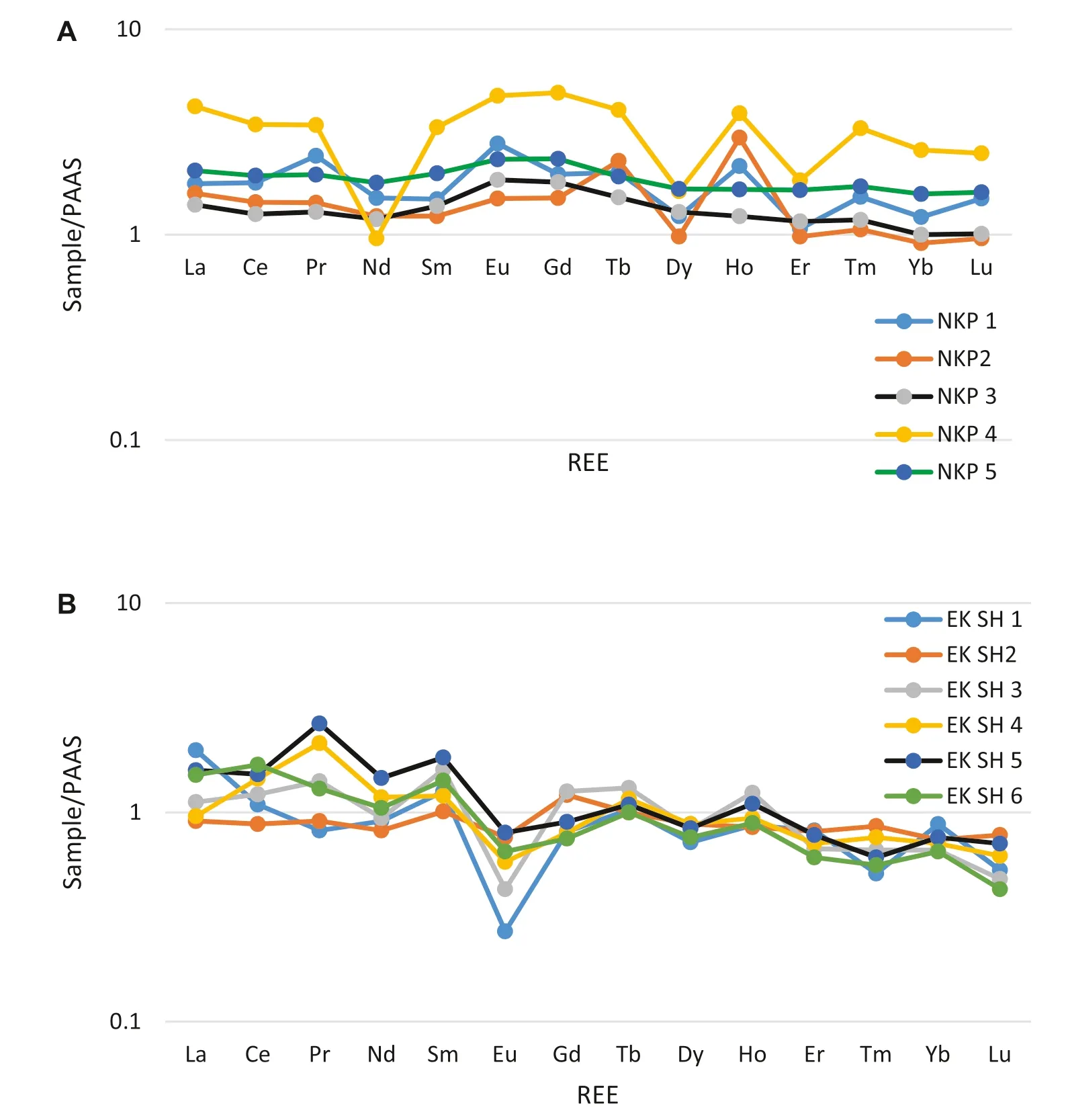

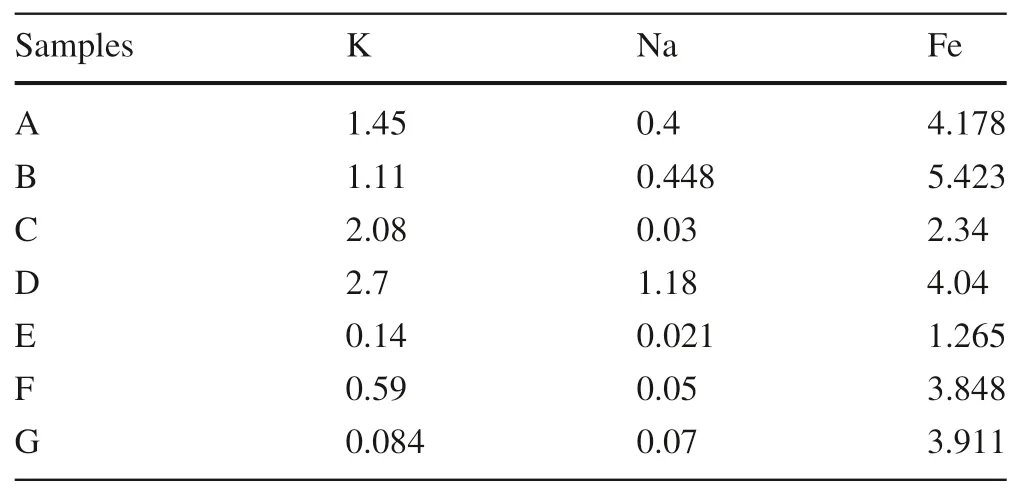
Samples K Na Fe A 1.45 0.4 4.178 B 1.11 0.448 5.423 C 2.08 0.03 2.34 D 2.7 1.18 4.04 E 0.14 0.021 1.265 F 0.59 0.05 3.848 G 0.084 0.07 3.911
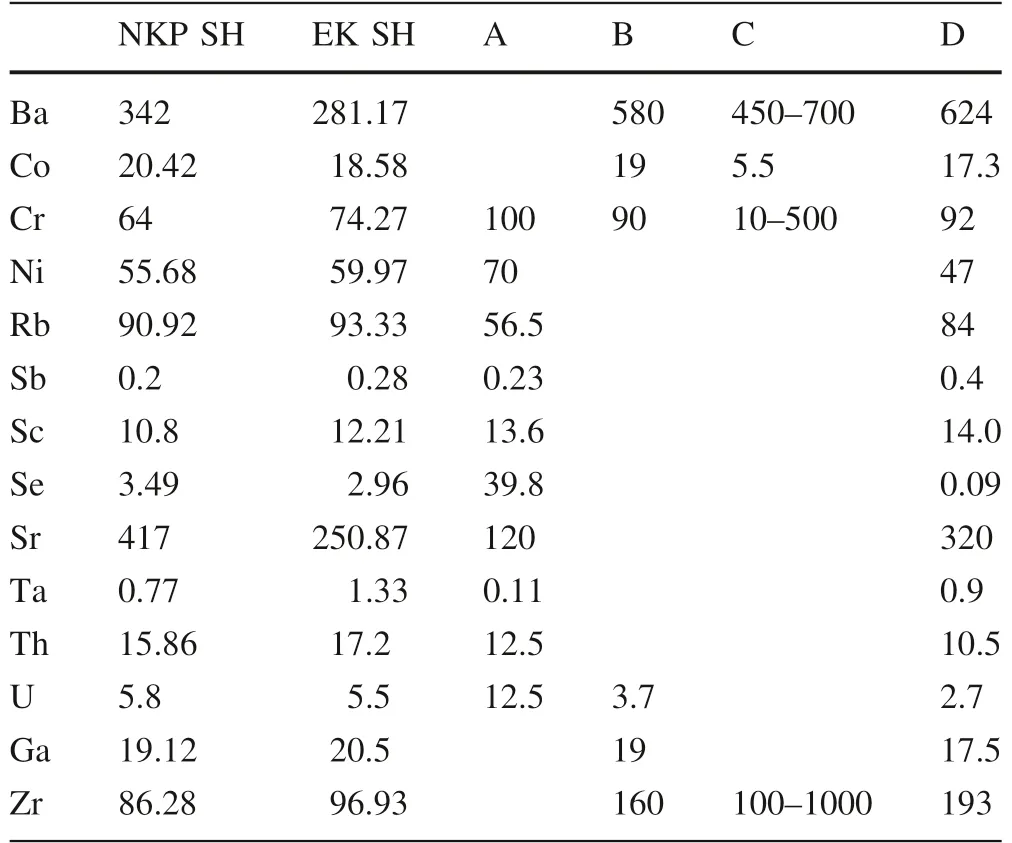
NKP SH EK SH A B C D Ba 342 281.17 580 450–700 624 Co 20.42 18.58 19 5.5 17.3 Cr 64 74.27 100 90 10–500 92 Ni 55.68 59.97 70 47 Rb 90.92 93.33 56.5 84 Sb 0.2 0.28 0.23 0.4 Sc 10.8 12.21 13.6 14.0 Se 3.49 2.96 39.8 0.09 Sr 417 250.87 120 320 Ta 0.77 1.33 0.11 0.9 Th 15.86 17.2 12.5 10.5 U 5.8 5.5 12.5 3.7 2.7 Ga 19.12 20.5 19 17.5 Zr 86.28 96.93 160 100–1000 193
4.3 Rare earth element
Rare-Earth Elements are also indicators for depositional environments and ore genesis of submarine hydrothermal exhalative deposits(Jiang et al.2006).The studied Nkporo shale shows a positive Ce and Eu anomalies while the studied samples of the Ekenkpon Shale show a negative Eu and positive Ce anomalies.
Positive Ce anomalies have been reported for a few samples from anoxic waters of the Black Sea(Jiang et al.2006).It has been suggested that the size and/or magnitude of the Ce anomaly def lection is mainly controlled by redox conditions and can be used as a tracer to distinguish between anoxic and oxic water bodies in the geological past(Shields and Stille 2001;Jiang et al.2006).Hence,Nkporo and Ekenkpon Shales exhibit a slightly small positive Ce anomaly which may ref lect anoxic conditions.
Positive Eu anomalies are commonly found in ores and chemical precipitates associated with massive sulf ide deposits and positive Eu anomaly has been regarded as one of the characteristic features of modern and ancient massive sulf ide deposits of submarine hydrothermal exhalative origin(Jiang et al.2006).It is believed that circulating hydrothermal f luids reacts with Eu-enriched feldspar bearing lithologies in the deep marine basin,which would mobilize Eu and cause a pronounced increase of Eu in the ore-forming solution and their precipitates(Graf Jr.1977).Hence,Nkporo Shale samples displayed a positive Eu pattern,suggesting that the shales are sulf ide and of seawater/submarine hydrothermal exhalative origin.
5 Conclusions
The Fe content in Nkporo and Ekenkpon Shales are relatively higher than that of the Oshosun Gery and Black Shales of the Dahomey Basin Southwestern Nigeria.Trace element ratios of V/Mo and V/(V+Ni)which are used to explicate the depositional environment suggest that the Nkporo Shale is deposited under anoxic to suboxic conditions and Ekenkpon Shale is also deposited under anoxic to suboxic depositional environment.The concentration of redox-sensitive elements(V,Ni,Mo,U,Cu,Cr,Re,Cd,Sb,Ti,and Mn)which are used to infer paleo-oceanographic conditions reveled that Nkporo Shale is deposited under dysoxic to anoxic conditions while Ekenkpon Shale is deposited under anoxic conditions.The average V/Ni of Nkporo Shale revealed that the organic matter in Nkporo Shale is of terrigenous origin.The average V/Ni in Ekenkpon Shale revealed that the organic matter in the shale is of mixed terrigenous and marine in origin.The results of the Rare-Earth Elements indicated that the Nkporo and Ekenkpon Shales exhibit a slightly small positive Ce anomaly which may ref lect anoxic conditions and the Nkporo Shale samples displayed a positive Eu pattern,suggesting that the shales are sulf ide and of seawater/submarine hydrothermal exhalative origin.
- Acta Geochimica的其它文章
- Heavy metal:a misused term?
- Enrichment characteristics and sources of the critical metal yttrium in Zhijin rare earth-containing phosphorites,Guizhou Province,China
- Evaluation of groundwater quality using pollution index of groundwater(PIG)and non-carcinogenic health risk assessment in part of the Gangetic Basin
- Adsorption removal of roxarsone,arsenite(III),and arsenate(V)using iron-modif ied sorghum straw biochar and its kinetics
- Spatial prediction and modeling of soil salinity using simple cokriging,artif icial neural networks,and support vector machines in El Outaya plain,Biskra,southeastern Algeria
- Episodic crustal growth and reworking at the southeastern margin of the North China Craton:evidence from zircon U-Pb and Lu-Hf isotopes of Archean tonalite-trondhjemite-granodiorite gneisses in the Bengbu-Wuhe area

